#Latin Names of Elements
Text
Formatio Verborum Latinorum / Formation of Latin Words
Fluorum -i n. “Fluorine”
[fluor “flow” + -us adjectival suffix]
[fluor- + -o-] stems
[fluoro-] new stem
[fluorus] masculine nominative singular
[Fluorum] neuter nominative singular
(Fons Latini Nominis Elementi.)
#Formation of Latin Words#Fluorine#Fluorum#Names of Chemical Elements#Names of Elements#Latin Names of Chemical Elements#Latin Names of Elements#latin#latin language#latin translation#lingua latina#tagamemnon#latin fandom#latin meme#latin memes#meme#memes#Word Formation#Latin Word Formation#greek meme#greek memes#Greek#Greek language#Greek translations#lingua graeca
3 notes
·
View notes
Text
ngl guys if I see someone dumb down Natlan to being purely "oh it's based off of Africa-" once more I am going to cry ngl.
it's name literally is Nahuatl, which is the Aztec language. it DOES have portions from African cultures, but it's mostly Latin American in it's themes. It seems to be taking themes from MULTIPLE cultures across the Ring of Fire in the end. The cultures it's based off of is extremely varied and a lot of pre-colonized ones as well.
Hoyoverse has been pushing the Latin themes in our faces since day one for Natlan, and still actively do so. It is mostly a mix of Latin American and African cultures with others (like Australian) in it as well.
This is the second nation in Genshin with African cultures noticeably mixed in, previous being Sumeru... which also really made their guys so pale for no reason.
#ymir sketches#hoyoverse#genshin impact#natlan#I keep getting annoyed at folks immediately locking onto the African elements than the Latin ones ngl mostly#because how in your face it is about Latin themes. like... how.. how do you ignore that?#this also may just be my brain going 'but THE OTHER THEMES-' to literally everything ever in all genshin regions#The obvious inspirations (mostly via the names) should kinda of be a focus ngl when talking about any of them in my brain.#it just. confuses the hell out of me when people do not recognize that all these nations have MULTIPLE cultures in them.#I still can't believe it's far more easier to find starrail npcs that have more pigmentation than in genshin ngl.#and that's including the playable characters ngl as well.#dying here ngl. irl. but that's only making it annoying to type some of this but#Natlan's whole thing has already been hinted at us as it usually is at the moment slightly before the release (summer event)
13 notes
·
View notes
Text
hahaha, the new Eibon Map is so large, I can't even upload it to tumblr! Discord can't handle its file size, nor can google, wonder where I could possibly host the image? Oh well, here's the old map with the incorrect hex sizes and with the Far East/Jinwa and Kihara on the map before they were split off into their own continents seperate from Eibon.

#ttrpg#I don't want anyone complaining about the names of Kihara and Jinwa#The people who actually speak those languages came up with them so I nodded and agreed with their ideas#For some reference Jinwa is the one in the top right with the classical element names and Kihara is the kinda-tropical island at the bottom#In our current version Jinwa has been spun into its own continent which takes cues from lots of differing asian cultures#the classical elements theme is still there but it isn't as all-consuming as it was in this first draft#Kihara is our group's work at making a latin/south american fantasy setting inspired by the really colorful myths that folks have#Eibon in general is more based off mythology and culture than say dnd fantasy tropes#three guesses who was obsessed with mythology books as a kid
3 notes
·
View notes
Text
20 Victorian-era names for girls
Adelaide: Derived from the Germanic name Adalheidis, meaning "noble" or "of noble birth."
Beatrice: Derived from the Latin name Beatrix, meaning "she who brings happiness" or "blessed."
Charlotte: Of French origin, meaning "free" or "petite."
Clara: Derived from the Latin word clarus, meaning "clear" or "bright."
Edith: Derived from the Old English name Ēadgyð, meaning "prosperous in war" or "blessed."
Eleanor: Derived from the Old French form of the name Aliénor, meaning "bright," "shining," or "light."
Florence: Derived from the Latin name Florentia, meaning "flourishing" or "prosperous."
Genevieve: Derived from the Old Germanic name Genovefa, meaning "woman of the race" or "tribe woman."
Georgiana: Feminine form of George, meaning "farmer" or "earth-worker."
Harriet: Derived from the French name Henriette, meaning "home ruler" or "ruler of the household."
Isabella: Derived from the Hebrew name Elisheba, meaning "God is my oath" or "devoted to God."
Josephine: Feminine form of Joseph, meaning "God will add" or "God increases."
Lillian: Derived from the Latin name Lilium, meaning "lily" or "pure."
Matilda: Derived from the Germanic name Mahthildis, meaning "mighty in battle" or "strength in battle."
Penelope: Of Greek origin, meaning "weaver" or "duck."
Rosalind: Derived from the Germanic elements hros, meaning "horse," and lind, meaning "soft" or "tender." But the meaning later changed to mean "lovely rose", from the Latin rosa lindaI.
Victoria: Derived from the Latin word victoria, meaning "victory" or "conqueror."
Winifred: Derived from the Old English name Winefrið, meaning "friend of peace" or "blessed peacemaking."
Prudence: Derived from the Latin word prudentia, meaning "foresight" or "wisdom."
Clementine: Derived from the Latin name Clemens, meaning "merciful" or "gentle."
More names

#writeblr#writer things#writersociety#writers#writers on tumblr#on writing#writerscommunity#creative writing#writblr#writing#writings#writers and poets#writer#writing prompt#writing advice#writing tips#writing community#writing inspiration#writing stuff#writer tips#writer problems#writer stuff#writer on tumblr#writer community#write#ao3 writer#writers block#names#character names#naming
3K notes
·
View notes
Text
My zine, 'Label Coining as an Artform', is finally done! Transcript/Image ID underneath (warning: it's long). Printed version in a reblog.
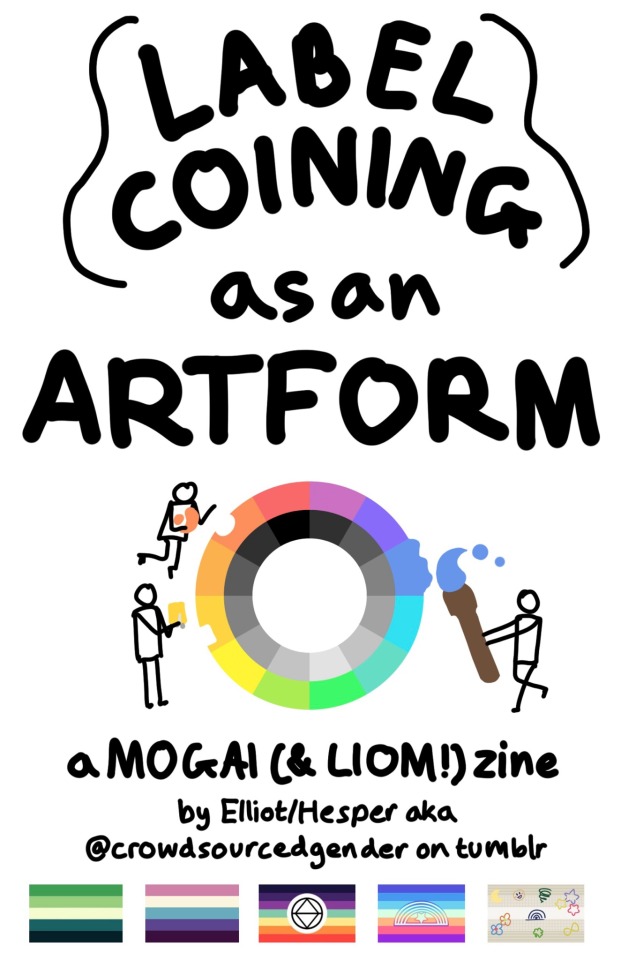

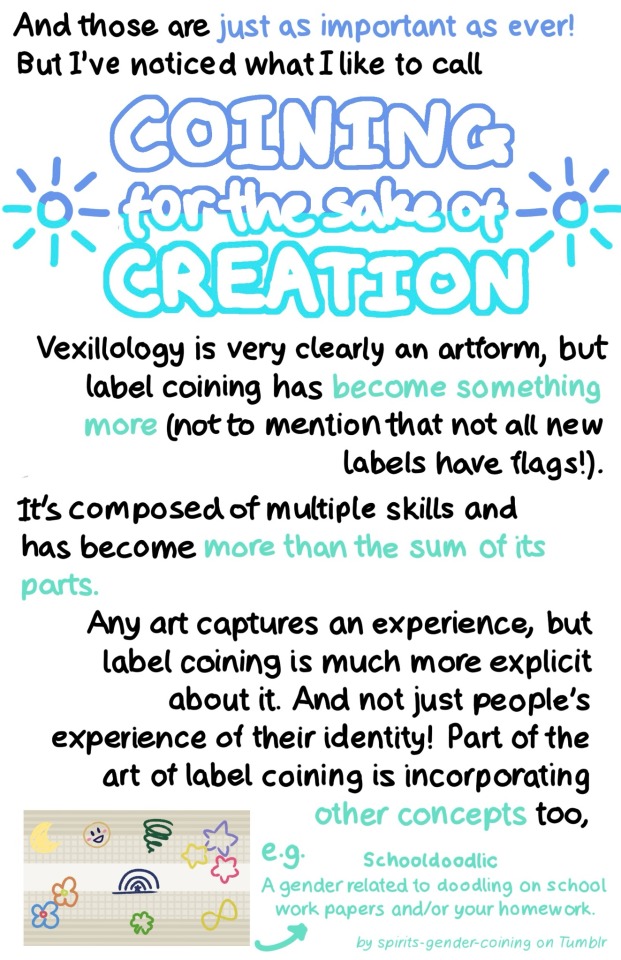

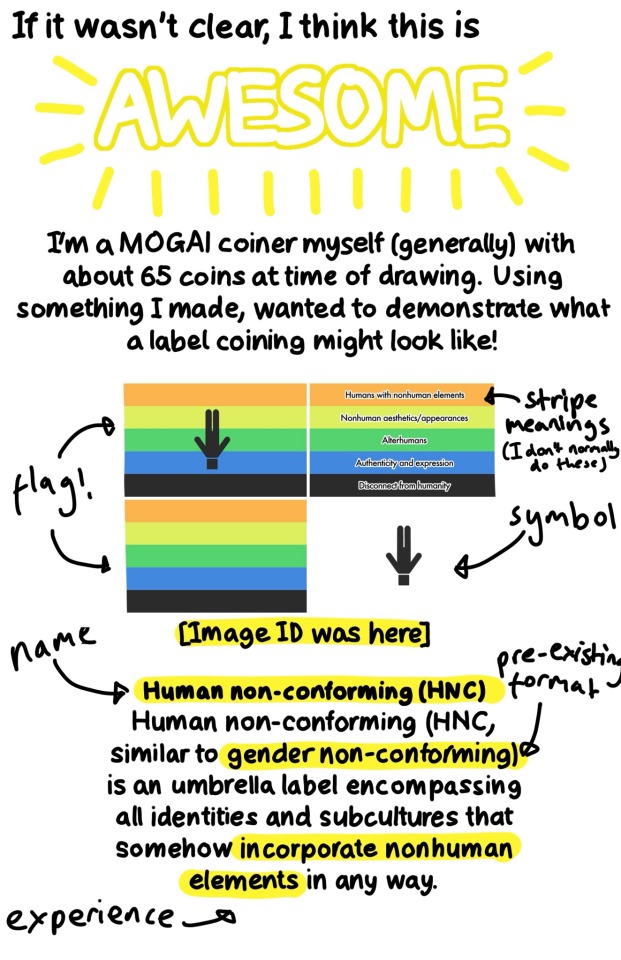
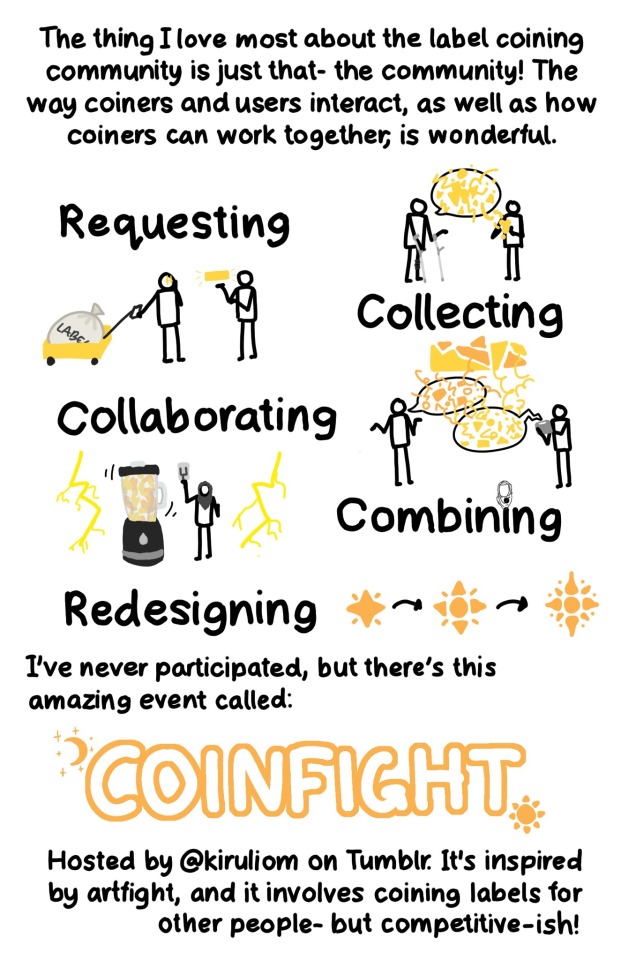



[Image ID: A series of pages in a zine. The text is handwritten, and all figures described are simplified stick figures.
Page 1: ‘LABEL COINING as an ARTFORM in large text. Below is the multicolored MOGAI wheel, with three figures taking pieces of the colors and using them for art: sculpting, cutting a piece of paper, and painting. Below is ‘a MOGAI (& LIOM!) zine by Elliot/Hesper aka @ crowdsourcedgender on tumblr. Under the text are five pride flags: aro-spec, veldian, alterhuman, xenoman, and schooldoodlic.
Page 2: ‘Label Coining’ in large pink text. ‘(in this context) is the act of creating a word (and usually flag) for a certain experience!’. Next to this text is a figure filled in with pink with a speech bubble full of pink shapes, talking to someone using a cane holding out a hand and expressing a question mark. Below reads ‘generally a queer experience, but does often include or incorporate disability, neurodivergence etc.’ A figure asks ‘Why?’ and the text reads ‘I would say these are the ‘core tenets’:’. In a cloud next to this text is a blue and purple pride flag with purple text reading: ‘like this cool prosopagnosia flag I made!’.
The bottom half of the page is split into two columns: ‘Understanding’ and ‘Community’. The first column has a purple arm amputee explaining a purple rectangle to another purple person who is thinking ‘that’s me!!’. Next to them another purple person is explaining the same rectangle to a blank person, who has a purple-filled thought bubble with a white exclamation mark. Underneath the drawing is text surrounded by question marks: ‘Labels help people understand what they are experiencing, and communicate this to others. It’s easier to explain something when it’s already been written down!” The second column has a purple person holding a purple umbrella. They are waving to a purple person in a wheelchair. A purple person is leading another one to the group. Underneath the drawing is text surrounded by connected dots: ‘People can unite under a shared label whether this group is big or small! Whether for practical purposes (like advice) or just for fun, having people like you is nice.
Page 3: ‘And these are just as important as ever! But I’ve noticed what I like to call COINING for the sake of CREATION’. This last phrase is in large, dark and light blue text. Two sun symbols are on either side. Below is the text: ‘Vexillology is very clearly an artform, but label coining has become something more (not to mention that not all new labels have flags!). It’s composed of multiple skills has become more than the sum of its parts. Any art captures an experience, but label coining is much more explicit about it. And not just people’s experience of their identity! Part of the art of label coining is incorporating other concepts too, e.g. Schooldoodlic A gender related to doodling on school work papers and/or your homework. By spirits-gender-coining on Tumblr.’ The text about Schooldoodlic is small and light teal. Next to the text is its flag.
Page 4: ‘Elements of Label Coining’. The text on this page is separated into four green boxes.
‘Naming: Coming up with the actual word can be tricky. Generally, labels with lots of elements get more leeway with length. It’s important to check that a label isn’t already a word as well.’ Next to this text is more rough, dark green text reading ‘Premade suffixes + prefixes help! And latin (for some languages) as it’s possible to intuit meaning!’ Around the text is a few examples: ‘-vesil’ ‘-musica’ ‘an-’ ‘quoi-’
‘Flag making: Also known as vexillology, this is a pretty big deal. It’s also the most fun for me! You develop a really good sense of color from spending so much recoloring the same three stripes.’ Next to the text is 6 versions of the same pride flag, each with slightly different colors, with a 7th final version with a symbol.
‘Symbol making: Most flags don’t have symbols, but they’re good for groups of labels under a certain umbrella, or just if you have a really good idea.’ Next to this is rough, dark green text reading: ‘I drew three semirealistic flowers for a flag and ended up only using one’ with sad face. Under it is a drawing of a daisy, a pink coneflower, and lavender, which is circled.
‘Descriptions/formatting: Explanations can be artistic in their own right, and formatting is fun to mess with: many people have their own style. Make sure it’s accessible: add image IDs and plain text where applicable. There are a lot of good resources online!’ In dark green text is the phrase ‘Accessibility over Aesthetics’ with an image of a key on top and sparkles below.
Underneath the boxes in light green text is ‘Note: in the right context, any of these can be optional!’
Page 5: ‘If it wasn’t clear, I think this is AWESOME’. Awesome is in large text with yellow radiating lines. Underneath is ‘I’m a MOGAI coiner myself (generally) with about 65 coins at time of drawing. Using something I made, I wanted to demonstrate what a label coining might look like!’ Underneath is four versions of the same pride flag as well as a description, with ‘flag!’ ‘stripe meanings (I don’t normally do these)’ ‘symbol’ ‘name’ ‘pre-existing format’ and ‘experience’ labelled. The description reads ‘[Image ID was here] Human non-conforming (HNC). Human non-conforming (HNC, similar to gender non-conforming) is an umbrella label encompassing all identities and subcultures that somehow incorporate nonhuman elements in any way.’
Page 6: ‘The thing I love most about the label coining community is just that- the community! The way coiners and users interact, as well as how coiners can work together, is wonderful. There are 5 large words each with an associated doodle.
‘Requesting’: A figure leaning on forearm crutches has a speech bubble with yellow shapes exploding out of it. Another figure is taking shapes down from the bubble and forming it into a ball.
‘Collecting’: A figure is pulling a yellow cart with a large cloth bag labelled ‘LABELS’. They have stars in their eyes, and are looking at another person who is gesturing to a yellow rectangle.
‘Collaborating’: Two figures, one with orange speech and one with yellow speech and an AAC tablet are discussing, with many shapes and lines intermingling to make a fragmented rectangle.
‘Combining’: A figure in a grey hijab pulls down a lever. They are standing next to a large blender mixing orange and yellow liquids. On either side is bright yellow lightning.
‘Redesiging’: A small star with four radial lines coming out of it becomes more and more complex, indicated by black arrows.
Under the words is the text: ‘I’ve never participated, but there’s this amazing event called: COINFIGHT. Hosted by @ kiruliom on Tumblr. It’s inspired by artfight, and it involves coining labels for other people- but competitive-ish!’ Coinfight is in large, text with a crescent moon with stars at the top right corner, and a star at the bottom left.
Page 7: ‘I don’t think there’s anything like finding a label that finally fits you, or hearing that something you made did that for someone else.’ Under is a figure looking at an orange flower with light lines, then forming elements of the flower into a bubble, then showing an orange rectangle to another figure, with orange tendrils reaching towards them, forming the shape of a heart. Below is the text ‘There are a lot of things like pouring out your heart- or just having fun- while making or collecting label. I coin in the same mind I sketch and color and shade.’ On each side is a pen drawing an orange figure with a red shirt, and a tablet with an orange and red flag. Under this is ‘Label coining is an artform both like and unlike any other, and I’m proud to participate in it. I hope that if you want to, you can join me. And if that’s not your thing- thanks for reading!’ There is a drawing of a figure with dark grey wings holding up two fingers. Next is a ‘<2’ heart and ‘elliot’ as a signature. In smaller text next to these is ‘Thank you to the creators whose work is featured in this zine! Credit on the next page. Remember to keep this wonderful community and artform accessible to all!’
Page 8: ‘Credit’: This section has a pride flag next to each label. ‘Aromantic-spectum, @ theflagarchive on Tumblr. Turian, @ kenochoric on Tumblr. Schooldoodlic, @ spirits-gender-coining on Tumblr. Xenoman, @ ryanyflags on Tumblr. MOGAI symbol, Pride-Flags on DeviantArt. Alterhuman, @ vaestra on Tumblr. (the flag on pg. 4 is Wildflowergender). ‘About making this zine’: ‘I really, really regret handwriting this. Drawing over Helvetica Neue for so long might change my actual handwriting, [more rough:] which looks like this! According to Artstudio Pro, I took 14 hours! I barely planned this before starting, the color wheel theme and the people doodles. /End ID]
#mogai#microlabels#mogai coining#lgbtq#lgbtqia#zine#art zine#lgbtq zine#queer zine#label coining#queer vexillology#queer#queer community#long post#described#image described#image id#not coining
558 notes
·
View notes
Text
Pluto generations
Aries (1823 - 1851)
The presence of Pluto in Aries defines a generation marked by a pioneering and assertive spirit, reflecting a profound longing for independence. Those influenced by this placement often take on key roles in instigating social change and revolutionizing established systems. Historical events from 1823 to 1852, such as the Wars for Latin American Independence, the First Opium War, and the Women's Rights Convention, exemplify the transformative impact of this astrological configuration.
Taurus (1852 - 1881)
Pluto's position in Taurus defines a generation characterized by unwavering perseverance, determination, and a profound connection to the material realm. These individuals prioritize stability, security, and the sustainable use of resources, leaving a lasting imprint on economic systems and environmental consciousness. Notably, during Pluto's transit in Taurus, the Industrial Revolution surged forward, marked by the rise of corporate structures in industries like railroads and steam engines.
Gemini (1882 – 1913)
The generation under the influence of Pluto in Gemini witnessed the dawn of the Second Industrial Revolution, aptly named the Technological Revolution. These individuals, marked by intellectual curiosity and adaptability, excelled in communication and media, significantly shaping cultural and technological progress. The era marked the birth of influential figures like John Maynard Keynes and Benito Mussolini, along with German scientist Robert Koch's identification of the tuberculosis bacterium. Notably, the First World War occurred during this period, bringing significant changes in all areas of life.
Cancer (1914 -1938)
Pluto in Cancer signifies a generation characterized by deep emotional sensitivity, nurturing instincts, and strong family values. Living through World War I, the Spanish flu pandemic, and the Great Depression, they grew up in a challenging era that shaped their conservative outlook. This generation, often referred to as the "Greatest Generation," prioritized family, spirituality, and adherence to societal norms. While their emphasis on politeness and chivalry had positive aspects, it also gave rise to dark elements such as sexist gender roles, racial segregation, and cultural supremacy.
Leo (1939 – 1958)
Pluto in Leo defines a generation marked by a quest for self-expression, creativity, and a hunger for recognition. Born during historical events like the Nazi invasion of Poland and the Battle of Stalingrad, these individuals challenged authority, imprinting their influence on art, entertainment, and leadership styles. Ruled by the Sun, Pluto in Leo symbolizes a fresh start after periods of war and chaos, fostering a sense of self-value and confidence. This prideful, generous, and naturally leadership-oriented generation, however, tends to resist change and stands firm in their philosophies as a fixed sign.
Virgo (1957 – 1971)
Pluto in Virgo defines a generation marked by a robust work ethic, practicality, and an innate drive for perfection. Born during pivotal events such as the first documented AIDS cases and Martin Luther King Jr.'s iconic "I Have a Dream" speech, these individuals contribute to societal shifts in health, wellness, and environmental consciousness. Ruled by Mercury, Pluto in Virgo emphasizes efficiency and hard work, fostering reliability, trustworthiness, and empathy. This generation focuses on rebuilding and technology, epitomizing an era of research and preparation, notably during the Cold War.
Libra (1972 – 1983)
Pluto in Libra defines a generation marked by a profound yearning for harmony, justice, and equality. With Venusian qualities, these individuals are inherently social, compassionate, and value connections with others. The events during their time, such as the end of the Vietnam War, the introduction of VHS, and the rise of personal computers, align with their commitment to justice and duty for the collective. This generation, while not necessarily seeking radical societal reshaping, is more focused on preserving law and order, offering assistance to those in need, and rectifying wrongs through the pursuit of justice.
Scorpio (1984 – 1995)
Pluto in Scorpio defines a generation marked by intensity, depth, and profound transformation, playing a pivotal role in societal shifts related to power dynamics, sexuality, and psychological exploration. While the preceding Pluto in Libra generation advocated for balance, Pluto in Scorpio pushed the limits, ushering in events like the Gulf War, the end of the Cold War, and the advent of the World Wide Web. Resilient and empowered, they navigated constant transformations, developing a keen ability to adapt and thrive through each metamorphosis. This generation also contributed to a shifting cultural perspective on sexuality.
Sagittarius (1996 – 2008)
Pluto in Sagittarius shapes a generation marked by a thirst for knowledge, cultural exchange, and a global perspective, contributing significantly to societal shifts in education, philosophy, and belief systems. This generation, embodies the archer's bravery and fearlessness, fostering a spirit of rebellion and outspokenness. Sagittarius' affinity for networking and socializing with individuals from various nations aligns with the rise of the internet, a tool that facilitates global connectivity. Key events during this period include the successful cloning of Dolly the sheep, the introduction of the Euro to financial markets, and the groundbreaking launch of the iPhone in 2007.
Capricorn (2008 – 2023)
Pluto in Capricorn defines a generation marked by ambition, pragmatism, and a distinct focus on challenging traditional structures, leading to transformative changes in politics, business, and governance. Ruled by Saturn, this era, encompassing events such as the launch of Bitcoin, the Syrian civil war, Edward Snowden's revelations on mass surveillance, and the COVID-19 pandemic, unfolded amidst the Great Recession and the rise of social media. The influence of Saturn instils a commitment to rules, regulations, and social changes that align with a desire for structure and order.
Aquarius (2024 – 2044)
Pluto in Aquarius heralds a generation marked by innovation, individuality, and an impassioned pursuit of freedom and social progress. The current era unfolds amid a new global order, carrying both anticipation and uncertainty. Emerging from the constraining Capricorn era, Aquarius brings a promise of hope, healing, and a future-focused mindset.
Pisces (2044 – 2067)
Pluto in Pisces gives rise to a generation marked by empathy, spirituality, and a deepening of the collective consciousness, contributing to societal shifts in compassion, art, and transcendence. As one era concludes and another begins, this period signals the resurgence of spirituality, with people connecting profoundly to the universe through meditation and prayer. Anticipated as a peaceful time with minimal conflict, technological progress may temporarily slow after the Aquarius era's boom. This wise generation is poised to challenge traditional norms, potentially leading to the disappearance of gender roles, marking a significant chapter in human evolution.
#astro observations#astro community#astro placements#all signs#astrology#astro notes#astrologer#for you#zodiac placements#pluto#planets#predictive astrology#astrology notes
711 notes
·
View notes
Text
The Meaning Of Villains' Names (ft Vogel)
Inspired by the post @.cherryisagamer made for Ikemen Prince here
Take most of these with a grain of salt, because of Cybird's weird naming tendancy as well as how names are in most cases are perceived in various ways by everyone. Also included extra information because I'm a silly little nerd.


Name: William Rex
Meaning:
“William” meaning “resolute protection/protector”
“Rex” meaning “king”
William is actually German in origin. It derives from the Germanic Wilhelm, whose roots wil (“will, desire”) and helm (“helmet, protection”) combine to mean “resolute protector”


Name: Liam Evans
Meaning:
“Liam” is the Irish short form of “William”, therefore same meaning as him
“Evans” meaning “the Lord is gracious”
Evans is a boy’s name of Welsh origin. An Anglicized form of Ifan, which stems from the Hebrew John, it translates to “graced by Yahweh” or “God is gracious.”


Name: Harrison Gray (I had to go check if his last name was with an e or a)
Meaning:
"Harrison" meaning “son of Harry”
“Gray” meaning... it's literally for the colour. Funny how game uses the US spelling for it


Name: Elbert Greetia
Meaning:
“Elbert”, a variation of Albert, meaning “noble; bright”
“Greetia”... I couldn't find any info about it. It's made up I presume.
This masculine name has Old English and German roots, coming from the name Albert. Translating to “bright,” “noble,” or “famous.”


Name: Alfons Sylvatica
Meaning:
“Alfons” (there are many variants btw) meaning “noble; ready; brave”
“Sylvatica” comes from the scientific name for forget-me-nots, “Myosotis sylvatica”
Alphons is a masculine name of German origin. Composed of apalaz and funsaz, it means “ready for battle,” “noble,” and “brave.” This sweet moniker is thought to be ultimately derived from the Latin Alphonsus and boasts a wide variety of variants, such as Alfonso, Alfonzo, and Alphonso.


Name: Roger Barel
Meaning:
“Roger” meaning “famous warrior”
“Barel”... I couldn't find reliable sources. Or maybe it does have an obscure meaning.
This name is forged from the German elements hrod and ger, imbuing it with the striking translation of "famous spearman."


Name: Jude Jazza
Meaning:
“Jude” meaning “praised” and praised is he in the jp server
“Jazza”... I think saw a post here saying how it's a form of Jeremy? But I can't find it now. There's something similar in Arabic I found however, “Jaza” (pronounced differently, there's not much emphasis on the Z afaik) meaning “reward; recompense; good return” which I find fitting his themes of retribution for those not keeping promises and debts, how he keeps all his promises etc.


Name: Ellis Twilight
Meaning:
“Ellis” meaning “kind; benevolent”
“Twilight” in its literal sense, “dusk”. His eyes contains a similar colour palette + I believe it is a reoccurring theme with him


Name: Victoria
Meaning: “Victor” meaning “conqueror”
Victor is one of the earliest Christian names, borne (as Vittorio) by several saints and popes, symbolizing Christ's victory over death. Victor made it big in the English-speaking world during the reign of Queen Victoria, one of the few boys’ names popularized by a female version.


Name: Darius Vogel
Meaning:
“Darius” meaning “possessing goodness; maintains possessions well”
“Vogel”... German for “bird”.


Name: Nica Schwarz/Schwartz (I tried to do some research and it seems like both spellings are used. Please correct me if I'm wrong.)
Before we go in, I'd like to tell you that there's no single general meaning for his name. It could be the short form of something or entirely new. Both variations, i.e Nika and Nica yield separate results. And many sources claim differently. I've put together what sounds believable to some extent.
Meaning:
“Nica/Nika” meaning “true image; victory; very good; pure crystal water”
“Schwarz/Schwartz” meaning “black”


Name: Ring Schwarz/Schwartz
...Cybird has made questionable choices. So I went with what sounded nearest to his name: Lynn (it's so so much cuter for him)
Meaning:
“Ring” meaning “a small circular band, typically of valuable metal”
“Lynn” meaning “lake, waterfall, pool below a waterfall”
“Schwarz/Schwartz”... German for “black”
#ikevil#ikemen villains#cybird otome#darius vogel#ring schwarz#nika schwarz#ring schwartz#nika schwartz#william rex#harrison gray#liam evans#elbert greetia#alfons sylvatica#roger barel#jude jazza#ellis twilight#ikevil victor
185 notes
·
View notes
Note
Sorry if you’ve answered this before, but any tips on improving your technobabble?
I originally came at this problem from two different directions. The first one took considerably more time to enable.
(a) Be familiar (or get familiar) with the languages in which most scientific terms are coined: Latin and Greek.
I took Latin in high school, already knowing that I was a science person and that Latin was considered "the language of science". (And medicine, which also turned out to be handy for me later.) I also started studying Greek in college—and, sigh, I'm still studying it.
Once you're starting to get familiar with the languages, practice coining terms as you need them. While it's considered a failure of style in scientific naming to mix Latin and Greek in the same term, I've found it better to be guided by euphony than a slavish obedience to the rules.
Because sometimes a word or term just sounds right. "Temporospatial claudication", for example, was coined by running a Latin physics term head-on into a medical one. "Claudication" was (and still is in some countries) a term for a constriction in a blood vessel. Its origin in the Latin claudo- and clausum roots is responsible for the Emperor Claudius's name, which would once have implied somebody who limps secondary to such a circulatory problem. I simply bent the term's most basic meaning off into a different direction.
...So you see how that goes. Bang the roots together and see what successfully sticks.
The second approach is a little easier. But only a little.
(b) Base your coined terminology on the conventions and rhythms of real technobabble: by which I mean actual, technical scientific language.
The best way to pick this up in sufficient depth is by reading technical papers in your field of interest—lots of them—so you can see how the pros communicate to/with one another. Every field has its own jargon lying around just begging to be stolen... assuming you observe very carefully how it's correctly used. Otherwise you risk outing yourself as nothing but an interested but insufficiently-committed bystander. You must also be super careful not to screw with the interior grammar of such techspeak... as inevitably it'll have one.
For example: when I was tooling up for writing The Wounded Sky, I spent easily three months reading papers in/on hyperdimensional physics. (Not that I wouldn't have done this anyway. It's a fascinating subject, and before I went into nursing I'd been a physics major, so I had a fair amount of the necessary background to understand what I was reading.) Even in the 80s there were a lot of such papers around, and in those distant pre-Internet days I was helped a whole lot by living just across the road from the impressive science library at Cal State Northridge.
During that period I could be found in the periodicals racks once or twice every week, digging through the monthly journals on the hunt for material that would be germane to the plot I was boiling. I found ten times more goodies than I ever could reasonably have used. The toughest part was winnowing it all down to what I actually needed to scatter here and there for atmosphere's sake, or to plant in specific spots to grease the plot's wheels. (My favorite remains the [legit!] paper with the delightful title, "Taub-NUT Space as a Counterexample to Almost Anything.")
Anyway, I must have got something about that whole business right, since one Princeton physics professor whose work I'd cited at the end of the novel asked me if he could use it in teaching his classes. :)
But there's a third element involved; more an attitude that you apply to what you've produced while employing the first one or two approaches.
You have to treat your coined terms as if they're absolutely real... something that any person educated in the science you're working with would know. The voice and tone in which you write using them has to reflect this absolute confidence and commitment to their reality. Because if you don't—at least while you're writing—absolutely believe in them enough to speak confidently about them, no one else will believe in them either.
But then that's a solid general principle anyway. If you don't do something you've created the courtesy of taking it seriously enough to believe in it (or its reality inside the larger reality you're creating), it won't long survive contact with exterior realities like the inside of your reader's mind.
HTH!
ETA: here's that citation page from the end of Wounded Sky. I believe it remains the only Star Trek novel with a cites list at the end. :)
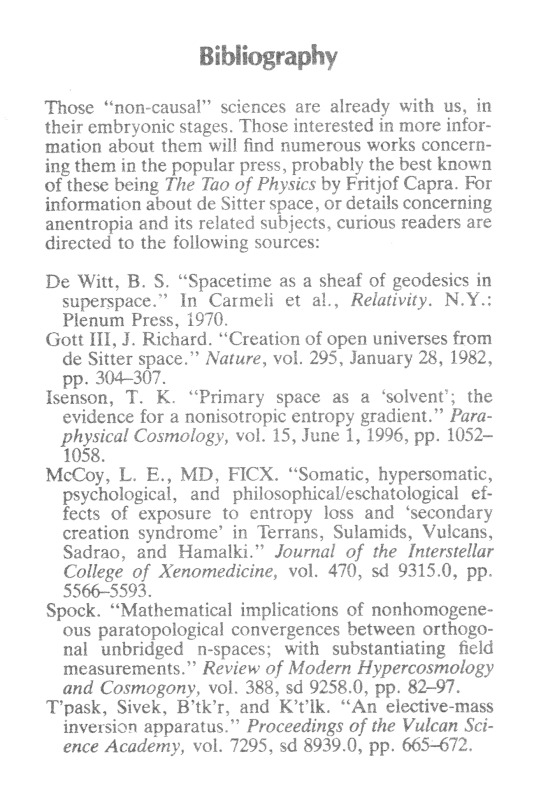
615 notes
·
View notes
Text
hello i have the geology flavor of autism an am so so normal about honkai star rail an have not stoped thinking about the myriad celestia trailer so im going to make a thread of fun facts about the gems/minerals each of the stone hearts are named after
topaz:
❥ topaz is naturally colorless but gets its color from elemental impurites
❥ the word topaz comes from the greek word Τοπαζος (topazos)
❥topaz is most commonly used in jewelry
❥ its the state gemstone of Utah!
Aventurine:
❥ Aventurine is a form of quartzite
❥ the word Aventurine comes from the italian word a ventura meaning by chance
❥ its a mineral! not a gem!
❥ green aventurine is the most common
Jade:
❥ Jade is actually the common term two diffrent minerals, nephrite an jadeite.
❥ nephrite is usually darker than jadeite due to it haveing more amphibole an jadeite having more pyroxene
❥ the word jade comes from the french l'ejade meaning kidney area
Sugilite:
❥ imma be honest i havent heard of this mineral before the trailer droped an thats probably because its very new as it was discovered in 1944!
❥ sugilite was discovered by Kenichi Sugi who it was named after
❥ most sugilite is purple or pink
Agate:
❥ Agate is the common term for the banded variety of chalcedony
❥ the word comes from the ancient greek word for the dirllo river, Achates where it is said to first be discovered
❥ Agate is formed from lava an volcanic rocks
Pearl:
❥Pearl is not a mineral as it comes from living creatures making it an organic material
❥ pearls are made of the same thing shells (an tums!), calcium carbonate
❥ natural pearls were most commonly found in the persian gulf
Sapphire:
❥ Sapphire is the blue variety of corundum, the second hardest mineral on the mohs hardness scale
❥ the word comes from the greek word σάπφειρος (sappheiros) but back then was talking about lapis lazuli
❥ Sapphire is one of the minerals used on sand paper!
Amber:
❥ not a mineral, it is fossilized tree resin so it is organic material
❥ 90% of the worlds Amber is located in Lithuania
❥ the word comes from the arabic word anbar
Opal:
❥ Opal is a mineraloid because its naturally occuring but doesnt have the crystaline structure of other minerals
❥ the word opal comes from the sanskirt word upala meaning jewel
❥ Opal is the national gemstone of australia
Obsidian:
❥ Obsidian is classified as a rock since it is formed rapidly cooling lava
❥ this baby is VERY sharp it was used in paleolithic times to make cutting an hunting blades and was used as surgical tools
❥ the word comes from the latin lapis obsidianus
#this took me two hours last night#orignally posted on twitter so i had to obey the word count limit#honkai star rail#hsr#ten stonehearts#ipc#hsr aventurine#aventurine#topaz#topaz and numby#hsr topaz#jade#hsr jade
238 notes
·
View notes
Text
Naming Fantasy Races, Step-by-Step
1. Understand their characteristics
What's special or different about them? Define their attributes—consider the physical, magical, and cultural traits of the race.
Determine their societal structure, beliefs, and history.
2. Choose a base word
Use elements from mythological roots or existing folklore and literature.
Draw from nature, such as "aqua" for water-based creatures or "sylvan" for forest dwellers.
Look at words from Latin, Greek, or other ancient languages for inspiration, such as "lupus" (Latin for wolf).
3. Find appropriate prefixes and suffixes
Examples of common prefixes:
Drac– (dragon)
Lycan– (wolf)
Syl– (forest/nature)
Aqua– (water)
Examples of common suffixes:
–kin (family, race)
–folk (people)
–ari (noble or magical)
–shade (mystical or ethereal)
–borne (born of or origin)
4. Combine & modify
Merge the base word with your chosen prefix or suffix and, if need be, adjust it to make for better pronunciation. For example, you might combine "sylvan" with "-ari" to create "Sylvari".
Mix parts of words to invent new, unique terms.
5. Ensure uniqueness
Once you've come up with a name, I suggest checking its uniqueness with a quick search to ensure the term isn't already widely used in popular media.
6. Contextual integration
Integrate the term into the lore and history of your world. How did this race come to be known by this name?
Consider the cultural significance. Think about how other races view them versus how they view themselves.
Here are a couple examples to get a better idea of how you might choose to go about it for different creatures:
Forest dwellers:
Base word: Sylvan (related to forests)
Suffixes: –ari, –folk, –kin
New terms: Sylvari, Sylvafolk, Sylvakin
Water-based beings:
Base word: Aqua (water)
Suffixes: –nix, –morph, –ari
New terms: Aquanix, Aquamorph, Aquari
Don’t be afraid to combine unexpected elements for a fresh take, and keep the cultural nuances within your world in mind when coming up with a suitable term. A race’s name might change based on who is using it or the context.
Hope you find this helpful! Happy writing ❤
Previous | Next
#writeblr#writing#writing tips#writing help#writing resources#creative writing#fantasy#fantasy writing#fantasy worldbuilding#mythical creatures#fantasy race#deception-united
312 notes
·
View notes
Text
Hi guys and welcome to Addie’s research spiral into the gay moustache:
Moustaches have always been a symbol of masculinity, sexuality and social standing
Like legit dating back to the 1800s we had the whisker and beard movement which started pushing the idea that facial hair can be masculine and sophisticated and not just a sign of lacking in morality and uncleanliness like the victorians used to think and you can actually draw a direct line to men feeling threatened to the patriarchy in those times and the prevalence of facial hair- this assertion of dominance and masculinity being seen similarly in ww1 soldiers, where facial hair became the accepted norm then post ww1 it went out of style again then this cycle repeats again with most wars.
There is also within the later 1800s and early 1900s links to sexuality and rebellion because younger men not having a full beard and instead having clean shaven faces or moustaches was seen as a sign of rebellion against older generations , also the need for maintenance of this style made it viewed as effeminate
Someone put it as the moustache has always been tied with the three fs: fops, foreigners and fiends meaning it was perceived that men would need to be well groomed or gay, foreign (particularly from Latin countries) or lacking in morals and evil to have a moustache
Okay so the origin of the gay moustache aside from the connection to the well groomed element
So post stonewall riots the gay moustache became a real thing like one qoute I found that was funny was arnie kantrowitz saying it was a requirement in the gay community, you needed a a flannel shirt, mustache or beard, bomber jacket, jeans and boots. We were dressing like the blue-collar men that turned us on." And a lot of it stemmed from what was dubbed the Castro clone look
Okay so Freddie was not in fact the originator of the Castro clone look
The castro clone look basically took all the really masculine and macho staples and made it extremely gay
The look originally being inspired by the men of the Castro neighbourhood in San Francisco in the early 60s and THAT actually comes from the “greaser”/hood look inspired by the 50s Italian American men and Latinos who also their subculture was born from their stereotypes
The Castro clone look doesn’t have one distinct origin but its popularity was fuelled by gay artists like Tom of Finland, and musicians like the village people and Freddie and gay pornstars like al Parker
And Parker was one of the big names in the Castro clone look this in particular not only explains the reason for his look well but also peep the “pouring beers over eachother” line and let me take you back to bachelor party buddie

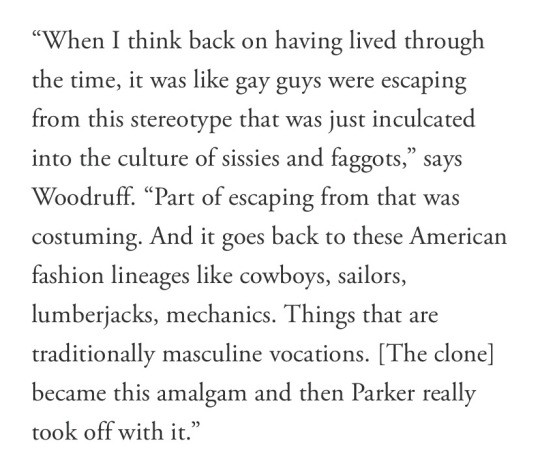
And now I hear the republican man and Gerrard mentions and to that I say that’s the whole point of it
Like the hypermasculinised look was meant to not only play the macho aesthetic and be a form of queer signaling but it was also meant to subvert gay men stereotypes by instead doing this like extreme portrayal of masculinity
It’s drawing from straight men but making it’s undeniably queer
Like wife beaters, moustaches, denims and flannels were so tied to het males that they took that and still found a way to make it so undeniably queer that it became a form of queer signaling
Thus taking the power away from the macho hets and forming a new subculture
The gay moustache only started seeing its end around the 80s AIDS epidemic because the moustache aimed to make a person look older but as queer communities became more sick or perceived as unclean or sick the need to look clean and young grew and clean shaved faces became the trend again
So Eddie having the moustache isn’t some tie to Gerrard or straight people it’s actually so queer coded and a form of rebellion
And btw this isn’t even a niche thing it’s like a widely known queer thing to the point that one show got slammed for having a gay club scene set in that time and not having any Castro clones in it
174 notes
·
View notes
Text
Formatio Verborum Latinorum / Formation of Latin Words
Lithium -ii n. “Lithium”
[λίθος “stone” + -ium element suffix]
[λιθο- + -io-] stems
[litho- + -io-] λιθο- Latinized
[lith- + -io-] o disappears before i
[Lithio-] new stem
[Lithium] nominative singular
(Fons Latini Nominis Elementi.)
#Formation of Latin Words#Lithium#Names of Chemical Elements#Names of Elements#Latin Names of Chemical Elements#Latin Names of Elements#latin#latin language#latin translation#lingua latina#tagamemnon#latin fandom#latin meme#latin memes#meme#memes#greek meme#greek memes#Greek#Greek language#Greek translations#lingua graeca#Word Formation#Latin Word Formation
3 notes
·
View notes
Text
One of the light-touch worldbuilding/storytelling/dramatic irony moments I really enjoy in Fallout: New Vegas is everything to do with Aurelius of Phoenix, the Legion Slavemaster operating Cottonwood Cove. Nested bit here, right? On first glance it seems like psuedo-Latin gibberish, something grandiose but divorced from meaning, like a lot of the Legion guys- but then you do the double take and realize it's a cognomen, a nickname Romans would receive based on great achievements or conquests-e.g. Scipio Africanus- and that implicitly this is the guy who helped sack the actual former city of Phoenix in Arizona. Stealth Future-imperfect trope, disguised at first glance because "Phoenix" is already a kind of grandiose mythologic-sounding word. And when you realize that, right, it's suddenly very funny, for the same basic reason The Republic of Dave is funny- grandiose terminology juxtaposed with a mundane name from the world we recognize. If it were Aurelius of Boise, Aurelius of Cincinnati, right, there are cities you could use in the pairing that would cause it to parse as much more of an explicit gag. So now it's silly in the way everything about the Legion is silly. But then it wraps back around to actually kind of unnerving, because first off, basically it's an offhand implication of something very nasty having gone down in Phoenix, A City From Real Life That We Recognize, in order for him to have gotten a whole Cognomen out of it. And second, it's obviously not a coincidence that his name doesn't sound dumb. Caesar isn't gonna let a subordinate quote-unquote "earn" a cognomen unless it's useful to him, unless it enhances the brand somehow, and having a guy named "Aurelius of Phoenix" walking around, well, it does do that! It feels calculated. It's not the kind of name that's downstream of cultural decay and half-remembered information. It's another example of how Caesar micromanages his slave army down to their very names, and how he lifts random superficial elements of Roman culture on an ad-hoc basis without integrating any of it on a deeper level. A lot going on, with this one guy's goofy name!
#fallout new vegas#caesar's legion#late night posting so not fully endorsed#but yeah there's a lot going on here#fallout#fnv#fonv#thoughts#meta
684 notes
·
View notes
Text
Alternative names for humanity along the lines of "Homo sapiens" (Wise man) and "Pan narrans" (Storytelling Chimpanzee) that I'm too lazy to look up/make up Latin for:
chef ape
throwing ape
walking ape
The idea being that we're apparently unique in the animal kingdom in that we cook our food, so we're the Chef Apes.
We're also one of the best animals at throwing things: humans have more accuracy and strength when throwing stuff than other apes, by a long shot
And apparently our ability to walk slowly for ages was key to our early survival as persistence predators. We can't outrun a gazelle or mammoth or whatever, but we don't tire easily and so we can just keep following it until it runs out of stamina
Pan basipila: the baseball playing Bonobo
If only baseball had a cooking element, it would be the perfect Human Sport.
We need to devise a sport where you cook something, follow someone for a long time, and then throw it at them.
The most human thing is the surprise pie to the face
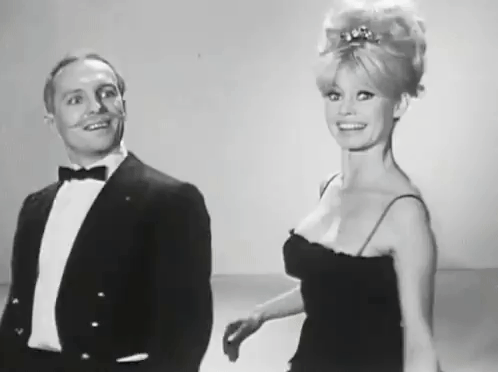
Also as much as I like Terry Pratchett's suggestion of "Pan narrans" I wouldn't be surprised if we turn out to not be the only animal that tells stories...
Elephants. I bet elephants do.
Like, there was that case where an injured elephant went to a ranger station for help. One it had never been to before, but other elephants had.
The theory being then that some other elephant had told this elephant "hey if you're hurt, go here, the humans will help"
That, combined with how they have burial rituals (some which might indicate there's an elephant religion!), and that we're working on figuring out how elephants communicate...
It wouldn't surprise me if we learn sometimes in the next decade or two that "oh yeah, elephants tell stories too. They've got FICTION."
So "Pan narrans" isn't what I'd want to bet on as our uniquely human thing.
But at the end of the day, maybe the whole idea of there being a uniquely human thing is, in itself, just another story we're telling.
So maybe it is a good fit after all.
But I especially like the idea that we're the Baseball Ape because I have this image in my head of a galactic council of aliens. Some angry alien who looks like Cthulhu had a baby with a spider has the floor, and they're ranting about "why do the Hu-mons deserve a seat?"
The Crogath are stronger, the Eldru are smarter, the Cybernetic Essense lives longer, the Dromans go farther and faster, the Moltriri have us beat in fiction and poetry, what is so special about these damn bipedal fleshbags that makes them unique in the universe?
And then WHAM.
Right between the eyes. A handheld translator device, a bit bigger than a modern smartphone, beans the speaker out of nowhere.
And there's an (untranslated) yell in the chamber as the prime representative calls for order.
"WE CAN THROW, MOTHERFUCKER!"
(it takes a while to properly explain the insult. Crogathi (especially drones) don't really have mothers or sexual reproduction, so they don't really get why that would be an insult. It's finally translated as something like "bud-biter")
and it's true.
even after the World Series becomes the Galactic Series, no non-human team ever manages to win.
The Eldrul Librarians almost make the cut in 2486 but accidentally piss off the ghost of Colonel Sanders and end up inheriting the Hanshin Tigers' curse.
alien textbooks describe The Colonel as some kind of human patron deity of baseball and cooked avian food, who should not be disrespected at all costs, or his vengeance from his place beyond the grave will be swift and punishing
(they're right)
"Look, we can't PROVE he was why Gemini Noctis went supernova unexpectedly, but given the protests that had happened right beforehand, and the incredible powers ascribed to the human spirits, do you really want to risk it?"
the funniest possible future:
humanity gets a key place in galactic politics because we're never able to adequately convince the universe at large that our ghost stories are just that, stories, and they're terrified shitless that we'll unleash spectral torment on them
"humans? look man, living humans are a pushover. you can easily rip them in half, crack their planets with a quark bomb, their ships are little more than tin cans with a tachyon drive taped on the side. but it's not the living humans you have to worry about... it's the ghosts."
"humans are a bit like the Nontilek, with a two-stage lifespan, a grub and an adult. What you think of as "adult" humans is just their infant stage, and they only fully transform once they "die". Once fully hatched into Ghost form, their powers are almost limitless."
you want humans off a colony planet and bomb them from orbit? good luck, now you have a few million ascended humans who can pass through solid matter and can't be killed, and they will never rest until you and your descendants are gone or dead.
you don't believe me? look at this: One of their most popular stories is about them building an empire that spanned a large chunk of their little planet, then having it MURDER THEIR OWN GOD.
It only worked for a few revolutions, and he just came back, promising that one day all of them would join him in the next phase of their lifespan.
They still, to this day, thousands of orbits later, erect little statues of the means they used to execute their deity.
not even the Crogathi, who literally worship death itself, tell stories that frightening to their newly hatched grubs.
Humans are scary, man, stay away and just give them whatever they want.
the rest of the alien's education on the dangers of humans is just a selection of human movies.
the sixth sense, poltergeist, ghostbusters, the shining, the devil's backbone, and, of course, field of dreams.
ghosts AND baseball?
it's everything they're scared about humans all in one package!
the obvious twist you could do, of course, is simple:
the aliens are right.
humans are a two-phase species where the elder form has immense power but leaves communication and decision making to the younger form, which will be confused and angry if you acknowledge the presence of their elder-stage members among them.
this often leads to them cutting off contact or their elder-stage members causing immense damage through seeming "accidents" on the contacting vessel. This is believed to be some kind of religious prohibition that they are not able to explain.
so it's official contact protocol to pretend you cannot perceive the elder-stage humans among them, and to give them what they want to avoid possible retribution.
No means to combat elder-stage humans has yet been found, and the limits of their power is not known.
All alien captains are required to study the fate of the SS Ennolon, which contacted a lone human craft in the galactic year of 12,783. They had initiated contact and were getting along fine, until the human showed the Droman captain a picture of their "late father".
Captain Droless, accounting for the difficulty in telling humans apart, then pointed at the father sitting in a chair nearby and said "That is them, correct?".
The human looked at the chair, reacted in confusion, then anger, and asked the contacting crew to immediately leave.
It was another 400 cycles before contact could be reestablished between the Droman Federation and the Human Alliance.
the intergalactic guide describes humans as a powerful race of immortal energy beings who have the strange habit of sending their larvae out on missions around the galaxy, occasionally contacting other races, but refusing to acknowledge their elders, except in stories
they seem to frequently put their young in dangerous situations without lifting a hand to help, so this is suspected to be some sort of pilgrimage or coming-of-age ritual.
(From a twitter thread on October 1st, 2022)
406 notes
·
View notes
Text
Writing Reference: Symbolism of Colors

Colors are proven to have a profound effect on the human psyche and moods.
Territories use colors to represent themselves on their flags.
The significance of colors is proven by the high value that our ancestors placed on certain plants or substances that could be made into dyes, such as the Imperial Purple of Rome that was produced from a mollusk that was valued more highly than gold, or the saffron crocus that produced the sacred color of the same name.
Prior to the development of chemical dyes, the creation of colors that did not fade in the Sun or wash away was a combination of art, science, and magic, akin to an alchemical process.
The impact of the Sun shining through stained glass, painting the interiors of churches with living colors that shimmered and danced, in a medieval world where color was often a privilege of the wealthy few, can only be imagined.
The 7 colors of the rainbow—which break down into 700 shades that are visible to the naked eye—are associated with the seven planets, the days of the week, the Seven Heavens, and the seven notes of the musical scale.
Symbolic Meanings of Some Colors
BLACK
Night, the absence of light; mourning, sobriety, denial; authority; perfection and purity; maturity and wisdom.
Although it’s the opposite of white, both shades are, in fact, due to an absence of color, and technically speaking black is not a “color” at all. This doesn’t stop it having a wealth of symbolic meaning.
BLUE
Truth and the intellect; wisdom, loyalty, chastity; peace, piety, and contemplation; spirituality; eternity.
There’s something cool and detached about blue that gives rise to its reputation for spirituality and chastity. Above all, blue is the color of the sky. Like the sky, blue is infinitely spacious. It contains everything, and yet contains nothing. The color is therefore associated with ideas of eternity.
BROWN
Poverty, humility, practicality.
Primarily associated with the Earth, soil, the raw element before it is covered with greenery. The word for earth, in Latin, is humus, which carries the same root as humility. Religious ascetics wear brown as a reminder of this quality and also of their voluntary material poverty.
GRAY
Sobriety, steadiness, modesty.
Gray is the midway point between black and white, and tellingly the “gray area” is an area of indetermination, indecision, or ambiguity. To be described as gray is rather less than flattering, since gray is such a subdued and neutral color, and implies that the person blends into the background.
However, gray is also a color of balance and reasonableness and is the color used, in photography, to balance all others.
Because people’s hair turns gray with age, the word is often used to describe elderly people and is also a color of wisdom.
GREEN
New life, resurrection, hope; the sea; fertility and regeneration; recycling, environmental awareness; a lucky color; an unlucky color.
Green is an amalgam of blue and yellow, and is the color of the
fourth chakra. Green is the universal symbol for “Go!” to red’s
“Stop!”
MOTLEY
Wealth; a chameleon personality.
Not strictly a color as such, but a combination of many other colors. The word is generally used to describe cloth or clothing. The rainbow nature of motley means that whoever wears it has as many aspects as there are colors, a chameleon personality, and it can indicate the trickster or fool (as worn by the jester, or the Fool in the Tarot) as well as kings, emperors, and deities.
In the Bible, Joseph’s coat of many colors is the object of much envy.
ORANGE
Balance between spirit and sexuality; fertility and yet virginity; energy; the Sun; like yellow, orange is believed to be an appetite stimulant.
Orange has two aspects that we see time and time again, pivoting between the material and spiritual worlds, which is not surprising given that the color itself is a balance between red and yellow. As such, it represents the second chakra, the first being red, and the third, yellow.
PINK
Femininity, innocence, good health, love, patience.
Pink is the ultimate feminine color, being flirty, girlish, and innocent at the same time. Pale pink is used as the symbol for a baby girl, just as pale blue is used for baby boys. This feminine angle is why the color pink has been adopted as a symbol of gay pride. Pink is the color of universal, unconditional love.
PURPLE
Royalty and pomp; power, wealth, majesty.
Purple, or indigo, is the color associated with the sixth chakra. Since it was first discovered, purple has been the color of choice to denote wealth and power. Emperors, kings, and the more powerful members of the clergy—such as bishops—choose the colour as a way of defining their status. This is because the dye itself was originally available from one source and one source only; the secretions of a certain gland of an unfortunate sea snail called the Murex brandaris. Therefore, purple was extremely costly to produce and strictly the color of those who could afford it, since the dye itself was more expensive even than gold. The most popular shade of the color is called Tyrian Purple (named for the city of Tyre, where it was manufactured).
RED
Vitality and life-force; fire, the Sun, the South; blood; good luck and prosperity; power and authority; masculine energy; war and anger; passion, energy, sexuality.
One of the three primary colors, bright red pops out of whatever environment it happens to be in and grabs our attention more than any other color. Moreover, it is the first actual color that is seen by babies.
SAFFRON
Spirituality, holiness, good fortune.
Named after the saffron crocuses whose stigmas create the color, the harvesting of these delicate plant parts is a labor-intensive and time-critical matter and so the actual dye is costly to produce.
VIOLET
Knowledge and intelligence; piety, sobriety, humility, temperance; peace and spirituality.
Violet is the color associated with the seventh chakra. There are many shades of violet ranging from ethereal pale shades through to the darker mauve, considered the only color acceptable as a relief from the relentless strict mourning convention of black and gray in Victorian times. Violet is a combination of red and blue, and its association with temperance is indicated in some Tarot suits.
The humble qualities of violet as a color come from the flower. The tiny violet grows close to the ground, hidden modestly in among the grass, yet noticeable because of its striking color.
WHITE
Purity, virginity; death and rebirth, a beginning and an end; in the Far East, mourning.
White is both the absence of any color and the sum of all colors together, so in a sense it can mean everything or nothing. This combination of all colors has given white the name of the “many-colored lotus” in Buddhist teachings.
YELLOW
The Sun; power, authority; the intellect and intuition; goodness; light, life, truth, immortality; endurance; the Empire and fertility [China]; cowardice, treachery.
Yellow is one of the three primary colors and is related to the third chakra which lives in the region of the solar plexus. This is apt, since yellow, like red and orange, is one of the Sun colors. It could be argued that yellow is the most dazzling of the three, so the association makes good sense.
Because leaves turn yellow and then to black with the onset of fall, in several places, including Ancient Egypt, yellow is a color of mourning. A yellow cross was painted on doors as a sign of the plague, possibly for the same reasons, and even today yellow marks off a quarantined area.
Source
More: On Colours
#writing reference#colour#symbolism#writeblr#spilled ink#dark academia#literature#writers on tumblr#writing prompt#poetry#poets on tumblr#studyblr#writing inspiration#rainbow#writing ideas#writing inspo#creative writing#writing resources#light academia
98 notes
·
View notes
Text
All Catholic References with Sunday (that I could find)

Well, for starter, I found lots of Catholic references with Sunday, and by extension, some elements in Penacony and even Xipe the Harmony. I feel like I have to write this down and post this. It's the reason this post exists.
Warning, this post will have extensive Bible quotes and religious references. If you are uncomfortable, please ignore this post.
Also, because I could only play the story only once and cannot go back to re-read the story, there will not be screenshots to everything.
Finally, spoilers of the newest Penacony trailblaze quest ofc
1. The name
Sunday's name is Sunday, and as you know, this is the day that is dedicated to God and most Christian (including Catholics) go to church to worship God. Sunday, right before he called upon the machine that he rode to become the weekly boss for the first time, he called it "Dominicus". This comes from the Latin word for Sunday "dominica", which means "the Lord's day". "Dominica" itself came from "Dominum, which means "Lord" or "the Lord". Even though the data bank calls the boss "Harmonious Choir" the Great Septimus, the detailed description of the boss still says "Dominicus".
If you search on the internet, you may find that the Latin word for Sunday is dies solis (which means the day of the sun). But that word was used in the pre-Christian era. Dies solis was changed to dominica after Christianity became the state religion of the Roman Empire in the 4th century. Till this day, English and other Germanic languages still call the first day of the week "day of the sun" in their respective languages, while other Romance/Latin languages call the first day of the week "the Lord's day", such as Portugese - domingo, Spanish - domingo, Italian - domenica, French - dimanche, etc.
2. Sunday's physical angelic features
Sunday was born a Halovian, a species in Star Rail universe well-known by their angelic iconography, having "halos" over their heads and white wings on the back of their heads. Although currently, only Sunday and Robin are shown to have wings, while other Halovian NPCs don't have them.
3. Confession
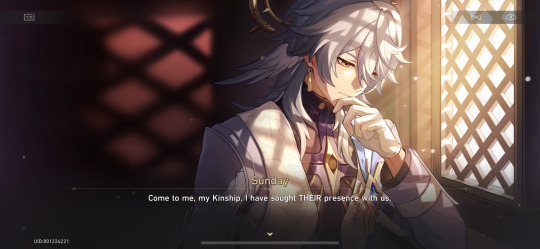
This one, I believe, is quite obvious, with Sunday acts like a priest hearing confessions of the people who came to him for guidance and a free-from-guilt conscience in what seems to be a confession booth.
4. "The creation of Adam"
Remember the cutscene with the boss in 3rd phrase reaching out the hand and touches another hand coming down from the sky.
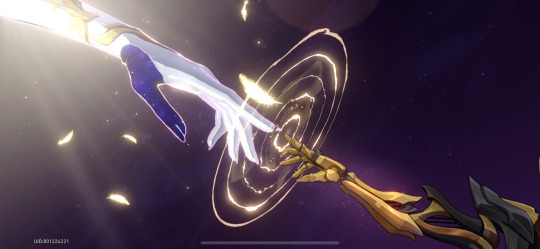
It''s inspired by this
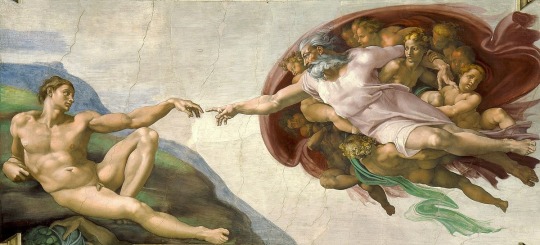
"The Creation of Adam" or "The Creation of Man" is a fresco painting by Michelangelo for the ceiling of the Sistine Chapel in early 16th century. This painting depicts God outstretching his right hand and finger towards Adam, the first man. This is mirrored and reversed by Sunday outstretching his right hand and finger from below toward the hand appearing from the sky. It is mirrored because in the original fresco, it is God reaching out for human with his right hand and Adam reaching out with his left hand, while in the game, the mysterious hand is a left hand while Sunday reaches out with his right hand. It is reverse because in the fresco, it is God who reaches out for human, while in the game, it is Sunday, a mortal, reaching up for the deity. However, we still don't know to whom that hand in the cutscene belong, I have compared that hand with both Xipe's and Ena's in their models, and it doesn't seem to belong to either of them, although the hand looks more like Xipe's than Ena's.
5. And on the eighth day
"And on the eighth day" is the name of the last quest of the trailblaze mission/main story quest chain of Penacony that was released in version 2.2.
In the quest, we hear Sunday telling us what Ena the Order did within the first seven days of Their existence. This is based on the narrative in the first chapter of Genesis, the first book of the Bible, God created everything in six days and He rested on the seventh day. If you have done the side quest to find clues about Sunday's whereabouts for Robin, you will get a notebook with the account of what Ena did in the seven days, the notebook is also divided into numbered chapters and verses, like the Bible.
Now we come to "the eighth day". In the 3rd phrase of the boss fight, each time the boss's turn comes, it doesn't attack but count the 7 days with its turns, corresponding with the narrative of Ena's first 7 days. And even on the 7th turn, the boss doesn't attack. It attacks on its next/8th turn after the cutscene, representing the eighth day.
Now in Catholicism, the day that Jesus rose from the dead is Sunday, the first day of the week. But Sunday is after the seventh day of the week, Saturday, so it's also called the eighth day.
"The eighth day, that is, the first day after the Sabbath [loosely corresponding to Saturday], was to be that on which the Lord should rise again, and should quicken us, and give us circumcision of the spirit." St. Cyprian of Carthage
"God brought it about that Christ’s body rested from all His works on the Sabbath in the tomb, and that He rose from the dead on the third day, which we call the Lord’s Day, the day after the Sabbath, and therefore the eighth day." St. Augustine of Hippo
6. Penacony's Phonograph soundtracks
I said that I also found some religious elements with Penacony. And I found those references with many of Penacony's phonograph soundtracks.
City Upon a Hill - the name is deprived from Jesus's words in Sermon on the Mount. You are the light of the world. A city seated on a mountain cannot be hid. (Matthew 5:14)
The Strength of Sin is the Law and The Sting of Death is Sin - now both of these came from the words of St. Paul the Apostle in his first Epistle (letter) to the Corinthians in the Bible, words for words. The sting of death is sin, and the strength of sin is the law. (1 Cor. 15:56)
Infirma Nostri Corporis - this is a phrase from traditional Catholic hymn Veni Creator Spiritus - Come, Holy Spirit, Creator. The phrase is an invocation of the Holy Spirit to strengthen our mortal body full of frailty and weaknesses.
Requiem Aeternam - eternal rest, this is a introit (hymn that is sung when the priest enters the church at the beginning of Mass). This introit is used at a Requiem Mass or Mass for the deceased or funeral Mass, a prayer to ask God to grand eternal rest to the deceased. Mozart wrote his own Requiem, which I believe to be the direct inspiration for this soundtrack and the next four. That means the original Catholic hymns are indirect inspirations.
Confutatis - confusion, this is a part of Sequence Dies Irae (Day of Wrath), which tells us about the Last Judgement. Confusion here means the confusion of the reprobate if you want the full context of this particular phrase. Also a part of Mozart's Requiem Mass.
Hosanna in Excelsis - Hosanna in the highest (hosanna is a word that expresses adoration, joy and praise). This originally came from the words of the crowd when they acclaimed Jesus at his Entrance into the city of Jerusalem. (Matt. 21:1-11; Mark 11:1-11; Luke 19:28-44; John 12:12-19). This was later incorporated into the praise Sanctus, which is sung at every Mass. Being an ordinary part of the Mass, the Sanctus is also a part of Mozart's Requiem.
Agnus Aeon - Lamb of Aeon, this is inspired by Agnus Dei - Lamb of God, another hymn that is present at every Mass. The hymn itself was inspired from the Bible, when St. John the Baptist called Jesus "the Lamb of God" (John 1:36). In Star Rail universe, when saying "god", the Aeons come to mind and the soundtrack's name was subsequently adopted to fit in the story. Also a part of Mozart's Requiem, same case with Sanctus.
Lux Aeterna - eternal light, the name comes from the hymn that is sung at the end of the Requiem Mass. The whole context is a prayer to God to let eternal light shine upon the departed.
7. Xipe - the Triple-Faced Soul
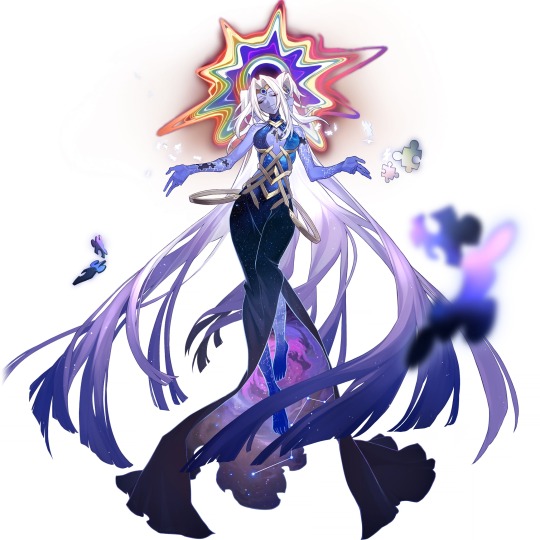
One of Xipe the Harmony's titles is the Triple-Faced Soul, and you can see They have three faces (or heads?) from Their model. They are also called "thousand faces", but here I'll be discussing the Triple-Faced only.
Now Xipe's three faces reminds me of the Holy Trinity, especially the depiction of the Trinity as Trifacial.
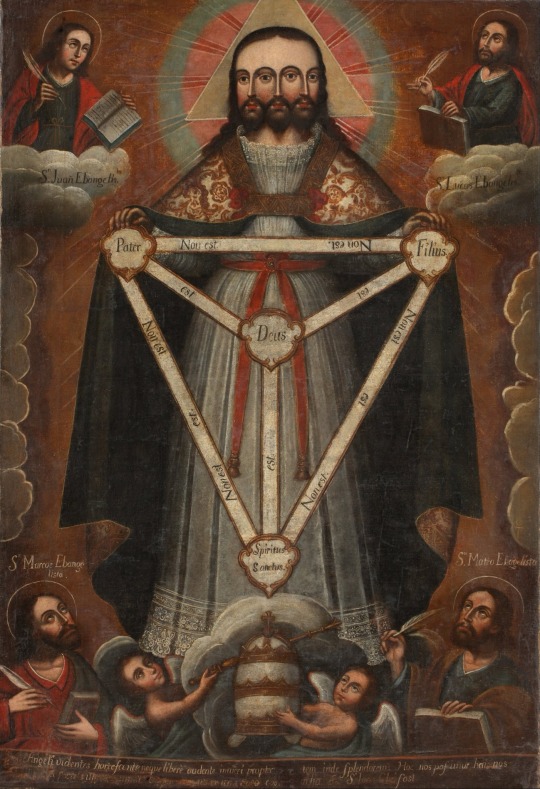
This kind of depiction of the Holy Trinity is not allowed anymore after the 1628 ban of Pope Urban VIII, who feared the depiction could make the people confused about the doctrine of the Trinity.
While the Trinity in Christianity is Three Distinct Persons but one God, one Divinity, Xipe is one person with three faces as symbolism.
I do know that gods in Hinduism have multiple heads, but I have only seen gods with 4 heads, 5 heads or even 8 heads. The only time I see a three-head god is when they depict Brahma, Vishnu and Shiva together as the Trimurti.
Well, those are all the Catholic references I could find and remember. Feel free to tell me if I missed something :3
173 notes
·
View notes